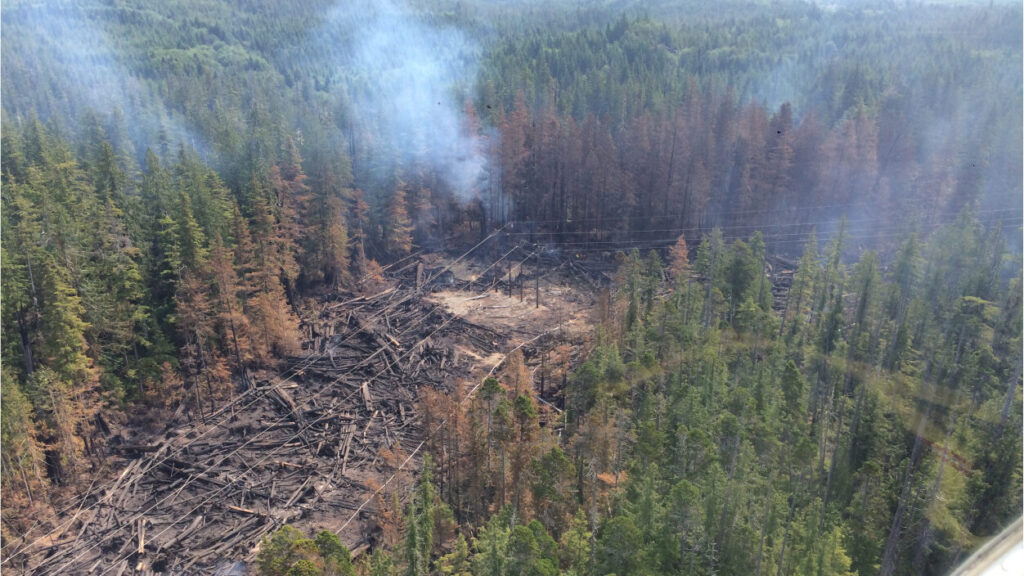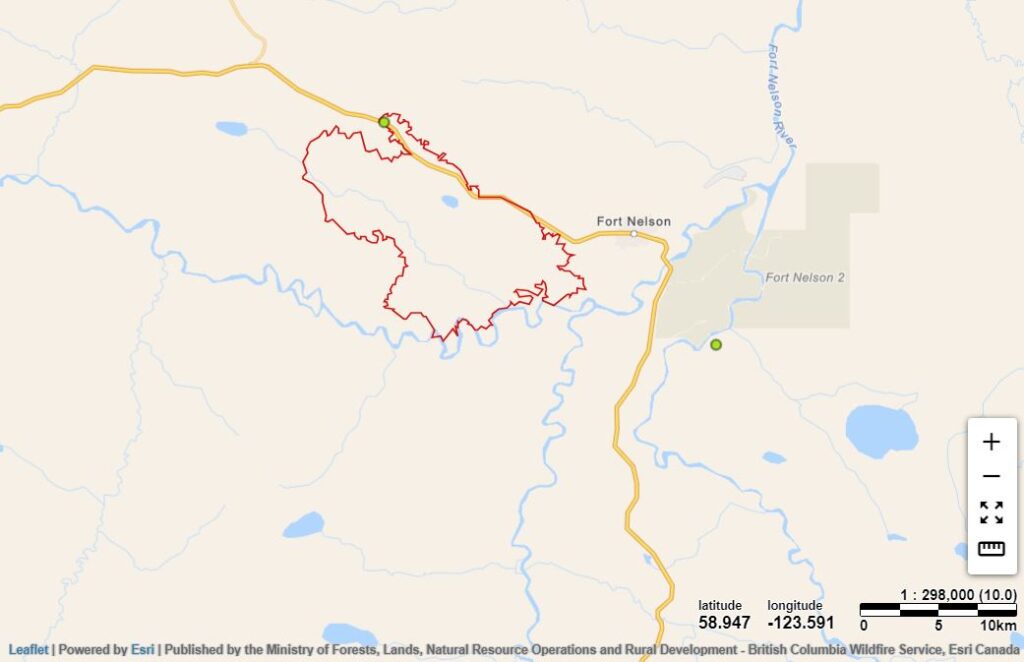Enhancing vision at BC Wildfire Service
|
With the threat of wildfires growing every year, fire agencies are being confronted with complex and time-sensitive decisions more often. At the same time, new AI support tools are emerging in the space, promising innovative solutions for difficult scenarios.
The Ministry of Forests and the BC Wildfire Service (BCWS) is already implementing AI through their use of remote sensing tools, with machine learning classifying large multi-spectral images from satellites.
Read described transcript
Describer: From inside a helicopter cockpit, we see wildfire smoke over forested landscape.
Neal McLoughlin, wearing a blue and orange jacket over a dark grey dress shirt, stands in a forested clearing.
Neal McLoughlin: There’s a lot of hype that AI is going to solve all the messy problems of the world.
Describer: A white subtitle fades in and out in the bottom right corner that says “Neal McLoughlin, Superintendent of Predictive Services, BC Wildfire Service.”
Neal McLoughlin: That’s not going to happen, but that doesn’t mean we’re not using AI in a transparent and responsible manner to improve public safety of our first responders.
Describer: A group of about 50 first responders, many wearing orange shirts or blue jackets, are briefed standing circled in the forest. In the background are parked pickup trucks and a camper that reads “Mobile Treatment Centre.”
In his office, Neal wears a blue dress shirt and reviews a map of wildfire data on his computer monitor. On the wall are various patches, a calendar, a whiteboard and photos of outdoor environments.
Neal McLoughlin: And the best example of that is how we’re using machine learning and satellite imagery to update the perimeter of an active wildfire.
Describer: On his screen, the red wildfire area grows larger.
Now in the forest, Neal walks through a dry clearing.
Neal McLoughlin: My name is Neal McLoughlin. I’m the Superintendent of Predictive Services for BC Wildfire Service.
Describer: Back in the office, Neal walks through a doorway.
Later, Neal and two other workers sit at a table and review a circular bar chart.
Neal McLoughlin: I don’t think AI will ever replace human intuition, but I am interested in how we can bring the power of data science and artificial intelligence to support the people that are making very quick, rapid decisions in a changing work environment.
Describer: In a parking lot, three first responders wearing blue caps and orange shirts read from a clip board and their phones. The patch on one shirt reads “Quesnel Fire Zone.”
Later, a group of six first responders in orange shirts and hard hats step further into the forest.
In the office, Neal sits in front of his desk. A set of seven color coded-binders are on the nearby table, and his three monitors display the BC Wildfire website and a map of B.C.
Neal McLoughlin: The biggest challenge that we face in modern fire agencies is…
Describer: We see rapid cuts of footage from various wildfires.
Neal McLoughlin: …capturing and updating our fire perimeters so that we know at any given time where a fire is and where it’s headed.
Describer: Inside a tent, one first responder in a black jacket and cap speaks to the rest of the group and refers to a pair of maps on a stand.
Neal McLoughlin: Some of our fires are hundreds of thousands of hectares in size, thousands of kilometres in perimeter.
Describer: Aerial footage shows massive amounts of flame and smoke on the mountains and coast.
An orange helicopter hovers in slow motion. A close-up shows tree branches burning.
A blue helicopter flies close to a large fire. From inside, the helicopter takes a tight turn over the smoke.
Neal McLoughlin: Traditionally, we would send aircraft up using a geographic position system to capture that boundary, but using helicopters to tightline a fire perimeter, flying at low altitudes, close to the ground, is simply not safe.
Describer: In a tent, two first responders wearing red shirts and blue caps in mid-conversation look concerned, hands on chins. In the background, a large map is pinned up.
Neal McLoughlin: We can’t do it that way anymore.
Describer: On a laptop in the tent, red satellite imagery can be seen overlaying a map of the area.
Neal McLoughlin: What we’re doing now is, we’re using satellite imagery to observe what fires are doing.
Describer: In an office, Ashlin Richardson wears a blue shirt and knit scarf, and types on a laptop keyboard. Visible out the window are trees and a residential home across the street.
On the screen, wildfire data appears as a 3D visualization.
Ashlin Richardson: My name is Ashlin Richardson. I’m a senior data scientist with BC Wildfire Service.
Describer: In the same room, Ashlin speaks to the camera. A white subtitle fades in and out in the bottom left corner that says “Ashlin Richardson, Senior Data Scientist, BC Wildfire Service.”
Ashlin Richardson: I’ve written a number of novel machine learning algorithms to map fire perimeters and help improve our situational awareness.
Describer: On the laptop screen, Ashlin types code in green on a black background. Next to the code is a black-and-white satellite image.
Ashlin Richardson: We’re using the shortwave infrared frequencies of Sentinel-2 to create an accurate delineation of active fire and burned areas.
Describer: On the laptop screen, a 3D map of a mountainous area loads gradually, and several orange spots indicating the fires appear.
Back in Neal’s office, the interview continues in front of his desk.
Neal McLoughlin: And as we do that, we can get more frequent updates, and we can do it in a safer way where we’re not putting our personnel on aircraft, and it frees up those aircraft to be used for suppression efforts and public safety measures.
Describer: A white and blue helicopter drops red powder onto a forested area bordering a town.
In the office, Neal and a team member walk past a wall of 16 framed vintage wildfire prevention posters. The visible ones say “A trash fire can burn more than trash,” “Smokey’s friends don’t play with matches — only you can prevent forest fires,” “Matches are not for children!!” and “Fire law May 1 – Oct. 31.”
Standing near a window looking out on the forest, Neal scrolls on a smartphone.
Neal McLoughlin: Throughout my career I’ve seen many new technologies introduced into my line of work.
Describer: In a common area, Neal reads from a laptop with a worker in a blue shirt that says “BC Wildfire Service” and a cap that says “British Columbia FireSmart.” A bulletin board in the background is covered in printouts, badges and children’s letters.
Neal McLoughlin: But one thing that’s unique about wildfire is that many people stay in this career path for a long period of time gaining experience and understanding how their actions translate to outcomes.
Describer: In the forest, one first responder passes a rolled firehose to another. A first responder wearing sunglasses and a hardhat whose nametag reads “Structure Protection Specialist” points off camera. Two first responders in hardhats speak to each other.
Neal McLoughlin: That is only obtainable through lived experience, and that, we can never replace with artificial intelligence.
Describer: Neal walks through the forest and out of frame. The scene fades to a white screen with the BC Public Service logo and the slogan “Where ideas work.”
A wider view: How remote sensing works
The human eye sees colours in the visible spectrum, but satellite imagery often contains wavelengths our eyes cannot detect, and at scales we cannot process. Machine learning algorithms allow us to classify imagery beyond the visible spectrum, extending our ability to monitor active fires and sense the environment at different scales.

Safer mapping
As we see an increase in large wildfires every year, mapping the boundaries of growing wildfire perimeters has become more complex. In days past, a firefighter would physically walk around the fire if it was small, or circle larger fires in a helicopter connected to the Global Positioning System (GPS).
As fires spread across larger landscapes, these helicopter rides get considerably longer and more hazardous in smoky conditions. (For example, the distance around the perimeter of the 2023 Donnie Creek wildfire was 1,234 km.) By processing satellite imagery through machine learning, the BCWS can monitor the shape and severity of large wildfires on a regular basis while staying out of harm’s way.


Growing capabilities
Innovations in remote sensing promise to improve wildfire intelligence from a public, internal and communications perspective, allowing for more up-to-date fire models and better predictions while providing more accurate information to people on the ground.
New algorithms are being implemented for satellite classification and the team is applying their experience to work with the federal government on new tracking satellites for 2027/28. As the team prepares for another fire season, there’s lots of excitement for the potential of these tools and future innovations to come.
Read more case studies highlighting the key results achieved when AI and human intelligence work together.
